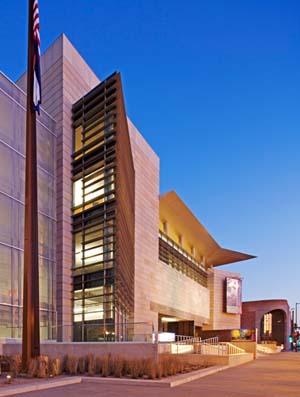The History Colorado Center, designed by native David Tryba, opens this Saturday.
 |
| Photo © Frank Ooms |
| The architect clad the 200,000-square-foot History Colorado Center in limestone. |

Denver’s Golden Triangle neighborhood, just south of stately Civic Center Park, has become something of an architectural showcase, with an eclectic assortment of works by Gio Ponti (the 1971 Denver Art Museum), Michael Graves (a 1995 addition to the Denver Public Library), Daniel Libeskind (a 2006 art museum expansion), and Brad Cloepfil (the 2011 Clyfford Still Museum). The area’s newest architectural attraction is the History Colorado Center, which opens April 28. And unlike its neighbors, the building was designed by someone actually born and raised in the state: Denver architect David Tryba.
Although not well-known outside of Colorado, Tryba has for years been quietly making a mark on his native state through some high-profile civic commissions, including Denver’s Wellington Webb Municipal Building, an addition to the Colorado Springs Fine Arts Center, and a new visitor center and parking structure at the Denver Botanic Gardens. Tryba, who founded his practice in 1988, works in a contextual style he calls “modern urbanism.” “We do contemporary buildings based on historically modern values,” he says., works in a contextual style he calls “modern urbanism.” “We do contemporary buildings based on historically modern values,” he says.
For the $110 million History Colorado Center, which replaces a much smaller building, Tryba clad the surface of the concrete-frame structure with horizontal panels of Indiana limestone, a nod to Denver Public Library’s original 1955 building, located a block away. Extensive windows allow passersby to see inside, particularly at night. During the day, light streams into the building’s most prominent feature: a four-story atrium, which doubles as a gathering space for public events. (In the old building, the main exhibition space was a windowless basement.) “I wanted the museum to be open and welcoming,” Tryba says. “Museums shouldn’t be the stuffy old places we experienced in our childhood.”
Inside, Tryba used local materials, including squared-off Douglas-fir logs (for benches), sandstone (for admission counters), and recycled beer-bottle glass (which adds sparkle to the terrazzo floors). Exhibition space accounts for about half of the 200,000-square-foot structure. The building also contains classrooms, a library, and storage areas, along with event space that will bring in much-needed revenue from rentals. Officials say the history center is a “reinvention” of the old museum, which was demolished to make way for a judicial complex.
At the new museum, says chief operating officer Kathryn Hill, the focus is on stories, not objects, with lots of hands-on displays and more technology. “We’re building this against a backdrop of diminishing attendance to history museums,” Hill says. “They’re perceived as static, and history is perceived as boring. Our idea was to build a building that turns the idea of what a history museum is supposed to be on its head.”


Post a comment to this article
Report Abusive Comment